February 2023 Edition

Dear DOB Customers,
As the Acting Director of the newly-established DC Department of Buildings (DOB), I am fortunate to lead a progressive team that is committed to building a culture of improved customer service, of equal access to services, of greater accountability, and of effectiveness.
Beginning operation on October 1, 2022, we are now in the second quarter of our fiscal year and these first five months have been exciting. We have three main pillars that will guide our work for the foreseeable future: innovation, technology and people. While these may seem familiar given our predecessor agency’s digital transformation, how we use these pillars to build on prior accomplishments so that we can further improve our ability to serve our customers will be different.
We have made a commitment to invest in our people. Through our Training Academy – which will increase knowledge among our existing staff, and increase the efficiency through which new staff will be on-boarded and make them better equipped to serve our customers – and our Career Pathways Program – through which we will begin building the workforce of the future in our industry – we are changing how we recruit, how we train, and how we work so that we may more successfully serve.
Democratizing District data and making our services more accessible are some of the main initiatives that drive our work every day. This is why I am excited about the recent release of our new DOB Public Dashboard – only one example of how we are using technology to better serve our customers and stakeholders. By reimagining how we share data for public consumption based in part on feedback received, we are now able to present more information in a clearer way, with greater access and opportunity for analysis. Though increased scrutiny will surely follow, we are confident that the end result will be one of better data quality, better understanding of our agency’s work, and greater value placed on data available through DOB.
Also, as you will read on, we are approaching our engagement a bit differently. Earlier this past summer, even before the agency was established, we committed to ensuring as seamless a transition as possible for our customers and we have succeeded. Continuous operations occurred and services were delivered. You may have noticed a shift in approach from our new agency recently. We began taking on a major community outreach effort to increase our agency’s presence within our community and to increase the touchpoints through which we engage with you so that they can be more collaborative, meaningful, and productive. We invite you to take a seat at the table and invest in our work: by engaging with us often, challenging yourself and us to think differently, and being open to a new view of what the built environment in the District of Columbia looks like.
In closing, thank you for your trust in DOB as we press forward.
Stay Safe.
|
 Ernest Chrappah
Acting Director
Black History Month is an opportunity to celebrate and recognize the important and innovative contributions that Black architects have made to their field. Here are a few notable Black architects who have had a positive impact on the built environment:
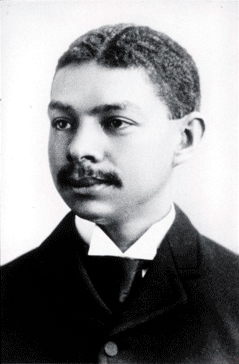
Robert Robinson Taylor was an American architect and educator. He was the first accredited African-American architect in the United States and is considered a pioneer in the field of architecture. Taylor attended the Massachusetts Institute of Technology (MIT) and graduated in 1892 with a degree in architecture. At that time, very few African Americans were able to attend college, let alone a prestigious institution like MIT. In addition to his work as an architect, Taylor was also an educator, a professor of architecture at what is now Tuskegee University from 1899 until his death in 1942. Taylor played a key role in the development of the architecture program at Tuskegee, which was the first program of its kind at a Historically Black College or University (HBCU). Photograph © MIT Museum.
|
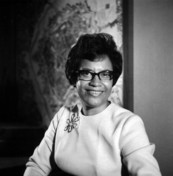
Norma Sklarek was an African-American architect who made significant contributions to the field of architecture. She was the first Black female architect to become licensed in the United States.
Throughout her career, Sklarek faced discrimination and prejudice, but she persevered and became a trailblazer for women and minorities in architecture. In 1980, she was elected as the first African-American woman to be a Fellow of the American Institute of Architects (AIA), and in 2008, she received the AIA's highest honor, the Gold Medal. Sklarek was a mentor to many young architects and served as a role model for women and minorities in the industry. She worked on a number of notable projects, including the Pacific Design Center in Los Angeles and the American Embassy in Tokyo. Photograph: © Gruen Associates.
|

Known for his pioneering work in the field of modern architecture, particularly in Southern California, Paul R. Williams was the first African-American member of the AIA and the first black architect to receive the AIA's Gold Medal. Williams was a prolific architect, designing more than 2,000 buildings during his career, and he received numerous awards and accolades for his work. In addition to his architectural practice, Williams was also a mentor to many young architects and was active in various civic and community organizations throughout his life. He designed many iconic buildings in Southern California, including the Theme Building at Los Angeles International Airport and the Beverly Hills Hotel. Photograph: © Herald-Examiner Collection / Los Angeles Public Library.
|

David Adjaye is a British architect of Ghanaian descent, known for his innovative and dynamic approach to architecture. Adjaye studied architecture at London South Bank University and later received his master's degree in architecture from the Royal College of Art in London. He established his own architecture firm, Adjaye Associates, in 2000, and has since become one of the most celebrated architects of his generation. Known for his innovative use of materials, bold geometric forms, and thoughtful consideration of cultural context, he has designed a wide range of projects, from private homes to public buildings, including libraries, museums, and cultural centers. Some of his most notable works include the National Museum of African American History and Culture here in the District, the Stephen Lawrence Centre in London, and the Nobel Peace Centre in Oslo. Photograph: © Pari Dukovic.
|
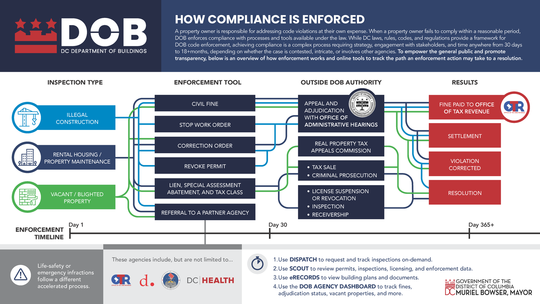 Defined by District law, enforcement action is complex, often misunderstood, and can be confusing or arduous for our customers to pursue. To assist customers and stakeholders in better understanding our role and authority, we have created an infographic to aid in transparency, increase knowledge, and establish the timeline of enforcement so that we can further build public trust in government.
- As DOB is only one entity in the enforcement process, the infographic also breaks down the points in the enforcement process where authority shifts to other agencies or entities, such as the Office of Administrative Hearings (OAH), and the Real Property Tax Appeals Commission (RPTAC).
- The infographic breaks down DOB's enforcement efforts into different categories based on the three main inspection types: illegal construction, rental housing and property maintenance, and vacant and blighted property.
- To allow customers to follow their issue through to resolution, digital tools such as Dispatch, our inspections-on-demand system, are also identified so that customers can monitor their inquiry from initial inspection request through to abatement, or until the matter is resolved through the adjudication process at OAH.
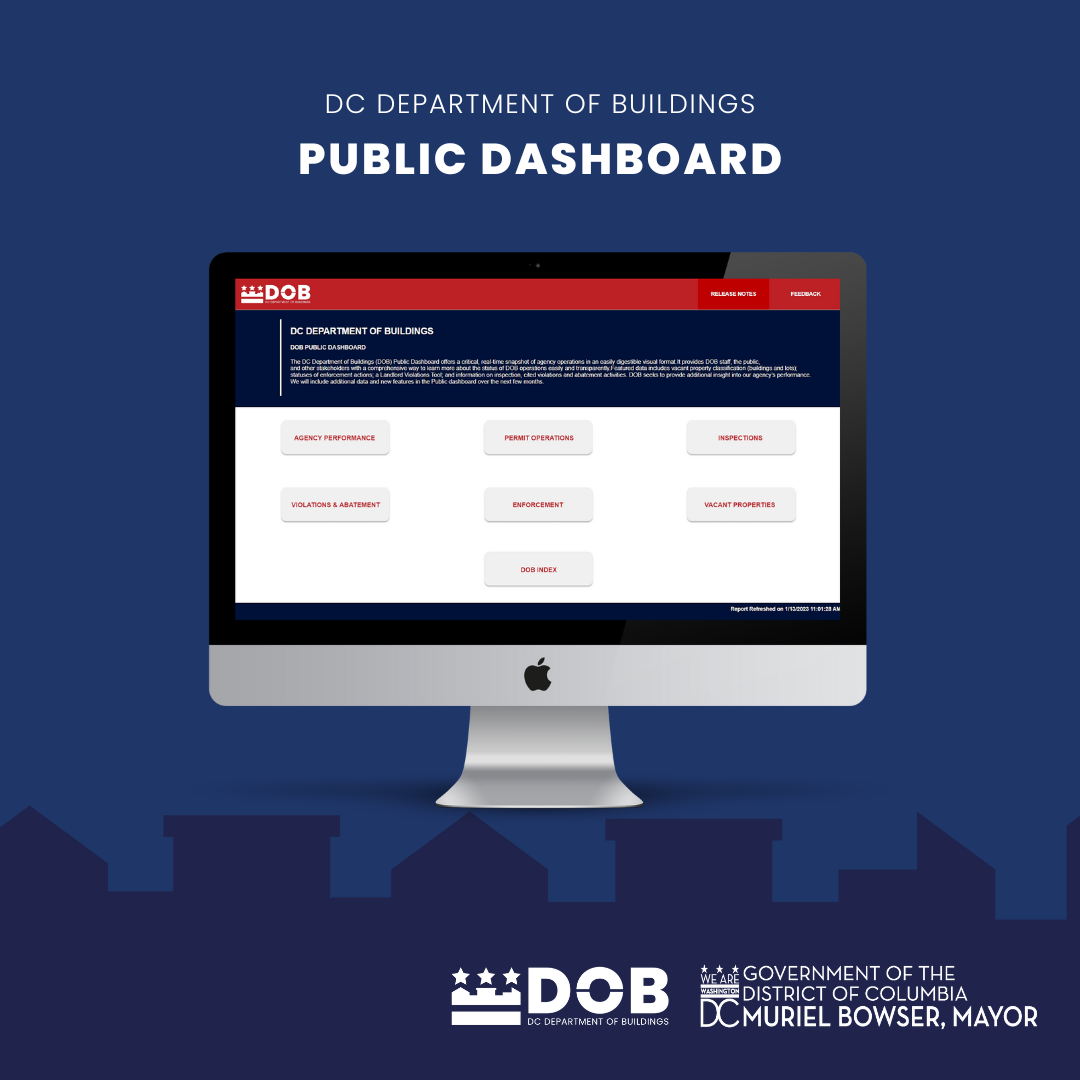 Last week, the DOB introduced a new DOB Public Dashboard that gives access to a wider variety of information and increases transparency by making data more accessible to customers and stakeholders.
Previously, the agency’s Performance Dashboard simply measured performance metrics based on DOB’s Service Level Agreements (SLAs) and made that data clearly visible to customers. The new Dashboard is much more robust, to include showing trends of certain construction metrics obtained during the permitting process, which will help better understand how the District is growing economically.
The Dashboard's new features include:
-
Economic Insights: the new DOB Index provides insight into the economic health of the District through a lens of construction activity.
-
Vacant Properties: new search features allow users to filter by ward, neighborhood, Advisory Neighborhood Commission (ANC), and Police Service Areas.
-
Violations and Abatement: our new dynamic search tool allows users to search multiple owners and by address with auto-complete features to amplify search capabilities.
-
Permit Operations: the Building Permits Issued view allows filtered views by fiscal year, quarter, month, and type/sub-type. The Average Days for Construction Permits view allows customers to see how long it takes to get a construction permit.
-
Inspections: this updated section now shows inspections by type, quarter, and ward.
-
Updated Design: with a new color scheme and layout, updated section headings include summaries of what elements are included in each category. Site navigation is improved thanks to the addition of filters, drill-downs, and the ability to further sort and organize the most important data. Users are also now able to download and export data spreadsheets – a request from many stakeholders.
 On February 27, 2023, the first cohort of students, graduates and post-graduate students will start in the DOB Career Pathways Program. The paid eight-week pilot program will provide alternative educational and professional experience to construction management, architecture and engineering majors. In creating this opportunity to increase industry knowledge among participants, we are also driving interest in those participants who have an interest in potentially joining the agency as full-time staff at the conclusion of the program.
Through recruitment partnerships at local institutions such as the University of the District of Columbia, George Washington University, the Catholic University of America, and others, we have sourced excellent candidates who will be placed in rotating roles in key agency departments to expose them to the work and processes, The goal is to shape participants so that they can be positioned for some of the jobs that DOB has open, including more than two dozen entry-level openings in plan review, inspections, program analysis, and green and natural energy.
 Career Pathways Program In The News
DOB Acting Director Chrappah joined Fox 5 recently to discuss the program. The Washington Business Journal also covered the program (a subscription is required to read the article).
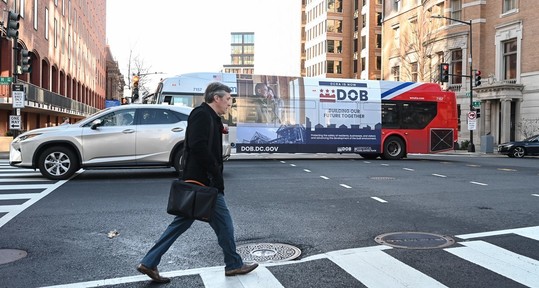 Increasing Our Engagement In The Community
Prior to DOB being established on October 1, 2022, we began a series of virtual public forums to begin educating and informing customers and stakeholders about DOB, what services we offer, and how to obtain those services. One the agency began operation, we also began a large community outreach program to keep residents and businesses informed.
As part of outreach, you may have noticed DOB appearing in more places throughout the District. In addition to a visible presence intended to further establish our agency, we are also committed to active engagement with customers and stakeholders. Now in the second quarter of our fiscal year, we:
- Have begun making training available for ANCs;
- Are set to provide additional quarterly trainings for the Mayor's Office of Community Relations and Services (MOCRS) so that they are better informed to assist us in serving residents and businesses;
- Have conducted proactive virtual meetings to solicit public engagement and inform customers and stakeholders on issues such as DOB's Strategic Enforcement Plan, permitting operations, and the neighbor notification program, and vacant property classification; and
- Had many listening sessions with tenant advocates, building and construction industry trade associations, with more being planned.
DOB Invited Customers and Stakeholders In For An Open House
 Last week, DOB and our sister agency, the Department of Licensing and Consumer Protection (DLCP), came together to host a joint Open House which brought more than 250 customers, stakeholders, and staff together for the first time since our agencies were established. This Open House was particularly meaningful because it was also our first large public in-person event held since the pandemic began.
Over the course of the evening, the response was overwhelmingly positive and appreciative. There was a heightened interest level in our work, and sentiments were shared acknowledging the enormous lift of setting up the two agencies, and fully understanding and appreciating the intention and progress made. Our agency has transformed how we provide government services – something noticed by our customers and also noticed by other jurisdictions.
To those who attended, thank you for coming out.
Ward 8 Community Walk With Mayor Muriel Bowser
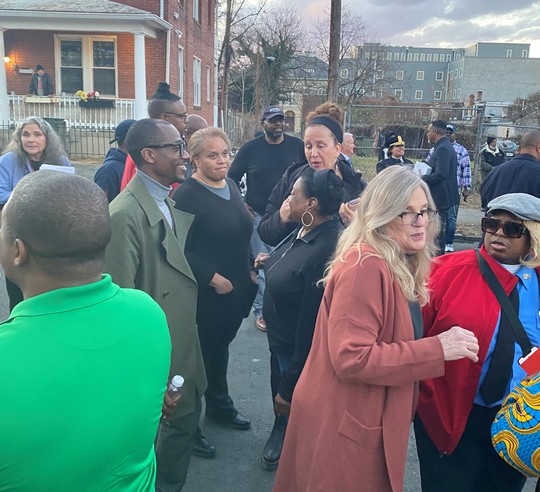 DOB Acting Director Ernest Chrappah speaks with Deputy Mayor for Operations and Infrastructure Lucinda Babers and other attendees of the Ward 8 Community Walk.
Last month, DOB Acting Director Chrappah and staffers joined Mayor Muriel Bowser and several other District government representatives to engage with Ward 8 residents and businesses on the Mayor's first community walk of her third term. Mayor Bowser also shared remarks and engaged with community members.
This event was an excellent way to kick off the new year; opportunities like these are an important part of our larger community outreach strategy, and we value each chance to interact with District stakeholders face-to-face.
 DOB's Role In Vacant Property Classification | What Triggers An Inspection?
One of DOB's roles in enforcement is to determine the classification and registration of vacant and blighted properties in the District. We also maintain a complete inventory of such properties. This inventory is published on the recently launched, new DOB Public Dashboard, on the Vacant Building Map and is updated daily.
How Are Vacant Properties Identified?
Once a complaint is received regarding a property, an inspection is conducted that allows us to determine the occupancy status of property. If a property is determined to be vacant or blighted, notification is provided to the property owner using the address on file with the Office of Tax and Revenue (OTR). If an owner disputes the vacant determination, the owner may file an appeal and provide evidence to establish occupancy. If a response and proper evidence is not received, OTR will be notified of the vacant or vacant-blighted status, and in turn will increase the tax rate to either a class 3 or 4 rate for residential and commercial properties respectively, in accordance with law.
The law is intended to encourage property owners to maintain their properties and ensure that they are in, or are returned to productive use.
How To Confirm The Occupancy Status Of Your Property
If you have recently purchased a new property in the District, have had a vacant status previously that no longer applies, or are just curious about your property's occupancy classification status, you may visit the Vacant Properties section on Public Dashboard, enter your address, and see your property's status. You may also want to search MyTax.dc.gov to confirm that tax rate for your property. This is especially important if you just purchased a home that was recently renovated, where a developer many have obtained an exemption that has expired.
What To Do If Your Property Has A Vacant Status And It Is Now Occupied
After checking the Vacant Building Map, if you find that your property has a vacant status and it is now occupied, please request a vacant property inspection online. After submitting the request, you will receive an confirmation email, a scheduled inspection date and a link through which you view the status of the inspection until completed.
We are currently exceeding our SLA to conduct 85% of vacant property inspections is 30 business days, coming in at 99.55%; however, we are often able to conduct inspections in as little as three days.
Applying For A Vacant Property Exemption
In certain circumstances, such as when a vacant property is under active construction, actively listed for rent or sale, or involved in probate proceedings, property owners may apply for a vacant property exemption which may prevent the tax rate from increasing. Exemptions, if granted, are for a limited time.
Contact DOB via email at dob@dc.gov, through our online inquiry form or during normal business hours using the live chat available on dob.dc.gov or by phone at 202.671.3500, and we will get back to you in three business days or less.
|